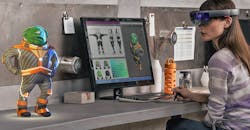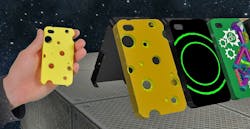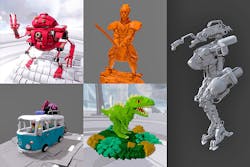3D Printing and VR: A New Spin on Design and Manufacturing
Download this article in PDF format.
What a day and age we live in when you can design and edit CAD models in a virtual- or mixed-reality environment and then readily 3D-print those models when finished.
It was only a short few years ago that those three technologies functioning together would have been considered science fiction rather than invaluable tools for design and manufacturing. The onset of (useful) virtual-reality (VR) headsets such as HTC’s Vive, Oculus Rift, and Samsung’s Gear VR have given designers an unprecedented viewpoint in allowing them to visualize their creations in a 3D environment and edit them in real time.
VR and MR bring a new level of design for 3D-printed CAD models. (Courtesy of Microsoft)
What’s even more impressive is that designers can even view their creations in real-world settings, under varied conditions, and subject them to different test parameters to see how they perform. This in turn provides invaluable insight on whether a redesign is in order if there’s a failure. The ability to rapid prototype those creations is just icing on the design cake and can be done in-house instead of having to endure lengthy turnaround from outsourced manufacturers.
Many questions arise when it comes to the future of VR-CAD design and 3D printing: Are they a viable one-stop solution? Are companies embracing the technologies? Will it have an impact on the maker community?
The short answer to all three questions is yes. In fact, major 3D modeling companies, such as Autodesk, Dassault Systèmes, and PTC Creo, among others, are embracing VR technology and implementing it into their respective platforms. Let’s look at what is currently happening regarding integrating all three to better gauge why those technologies pair well together like fine wine and aged cheese.
Combining CAD, VR, and 3D printing provide a one-stop shop for bringing 3D models to fruition—meaning you can visualize your creation, manipulate it, and prototype it without the need to outsource any part of the project from the design phase onward. No intermediaries, no increased funding required.
Sixense MakeVR lets you use hand gestures to create 3D models that natively export to STL for direct 3D printing. (Courtesy of MakeVR)
Convenience is also key, as some companies are now combining CAD with VR capability. For example, Sixense developed the MakeVR platform, which runs natively on HTC’s Vive VR headset, automatically saves files in STL format, and can be ported over directly to a 3D printer. Since I have both a Vive and a good 3D printer, I will be trying this out myself and soon!
Sixense designed MakeVR using Dassault’s 3D ACIS kernel, making for a powerful CAD platform with integrated freeform design tools to create 3D models. The ability to manipulate those objects using handheld controllers and hand gestures gives you the ability to view the model at any angle. Add to the fact that you can position the object in a native VR setting provides more intuitive information that isn’t possible with a flat-panel display.
Other VR modeling packages are more simplistic but offer features suited to specific applications, such as Oculus Medium. This platform provides an interface that’s akin to Microsoft Paint in terms of functionality. Instead of using “brushes” and “markers,” you implement tools to manipulate a clay-like mass—you’re able to mold it into anything or any object and give it color and textures. All of which is done in a spatial VR environment using motion tracking and controllers.
ESI Group’s IC.IDO VR platform makes it possible to design and take apart your own car and other complex models. (Courtesy of ESI Group)
Listed here are just a handful of CAD options that offer VR implementation and 3D-printing capability, which is a convenient solution for some applications in both the commercial and private sector. Are they capable of replacing traditional CAD platforms used for circuit design or mechanical modeling? Not completely, but it does signal where the technology is heading, and VR will certainly play a big part in how the technology evolves.
3D printers have been paired with CAD platforms since they became a popular prototyping option among makers in 2012. The synergy between the two will undoubtedly expand to incorporate VR as part of a natural, technological evolution that does indeed complement each other like a fine wine and aged cheese.
About the Author
Cabe Atwell
Engineer, Machinist, Maker, Writer. A graduate Electrical Engineer actively plying his expertise in the industry and at his company, Gunhead. When not designing/building, he creates a steady torrent of projects and content in the media world. Many of his projects and articles are online at element14 & SolidSmack, industry-focused work at EETimes & EDN, and offbeat articles at Make Magazine. Currently, you can find him hosting webinars and contributing to Penton’s Electronic Design and Machine Design.




